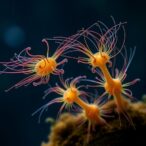
Source: Viaframe/Getty Image
In a new study published in Nature Metabolism titled “Neuronal Glycogen Breakdown Mitigates Tauopathy via Pentose Phosphate Pathway-Mediated Oxidative Stress Reduction,” researchers from the Buck Institute for Research on Aging have uncovered how the breakdown of glycogen may protect the brain from toxic buildup and neurodegeneration. The results could explain why GLP-1 drugs, now widely used for weight loss, show promise against dementia.
Glycogen is typically thought of as a reserve energy source stored in the liver and muscles. While small amounts also exist in the brain to support astrocytes, its role has previously been deemed negligible.
“This new study challenges that view, and it does so with striking implications,” said Pankaj Kapahi, PhD, professor at the Buck Institute and corresponding author of the study. “Stored glycogen doesn’t just sit there in the brain. It is involved in pathology.”
Led by postdoctoral researcher, Sudipta Bar, PhD, the study discovered that in both fly and human models of tauopathy, a group of neurodegenerative diseases including Alzheimer’s, neurons accumulate excessive glycogen that contributes to disease progression. Results showed that tau, the key protein that clumps into tangles in Alzheimer’s patients, physically binds to glycogen to prevent breakdown.
Glycogen buildup causes neurons to lose an essential mechanism for managing oxidative stress, a key feature in aging and neurodegeneration. Restoring glycogen phosphorylase (GlyP) activity, which catalyzes glycogen breakdown, led to reduced tau-related damage in fruit flies and human stem cell-derived neurons. Enzyme-supported neurons rerouted the sugar molecules into the pentose phosphate pathway (PPP)—a critical route for generating nicotinamide adenine dinucleotide phosphate (NADPH) and glutathione, molecules that protect against oxidative stress.
Results also showed that dietary restriction (DR) naturally enhanced GlyP activity and improved tau-related outcomes in flies. The authors mimicked these effects pharmacologically using 8-Br-cAMP to show that the benefits of DR might be reproduced through drug-based activation of this sugar-clearing system. The work provides a potential mechanism for how weight loss drugs, such as GLP-1, may protect against dementia.
Researchers also confirmed similar glycogen accumulation and protective effects of GlyP in human neurons derived from patients with frontotemporal dementia (FTD), strengthening the potential for translational therapies.
Kapahi said the Buck’s highly collaborative atmosphere was a major factor in the work. His lab collaborated with the proteomics expertise from Birgit Schilling, PhD, another professor at the Buck, and Nicholas Seyfried, PhD, professor at Emory University. In addition, Lisa Ellerby, PhD, professor at the Buck, supported the work with expertise in human induced pluripotent stem cells (iPSCs) and neurodegeneration.
The study opens new directions for treatments against Alzheimer’s and related diseases.
“By discovering how neurons manage sugar, we may have unearthed a novel therapeutic strategy: one that targets the cell’s inner chemistry to fight age-related decline,” said Kapathi. “As we continue to age as a society, findings like these offer hope that better understanding—and perhaps rebalancing—our brain’s hidden sugar code could unlock powerful tools for combating dementia.”



